Amusements Uninterrupted
A Look into the History of Fish House Punch, America's Original Cocktail
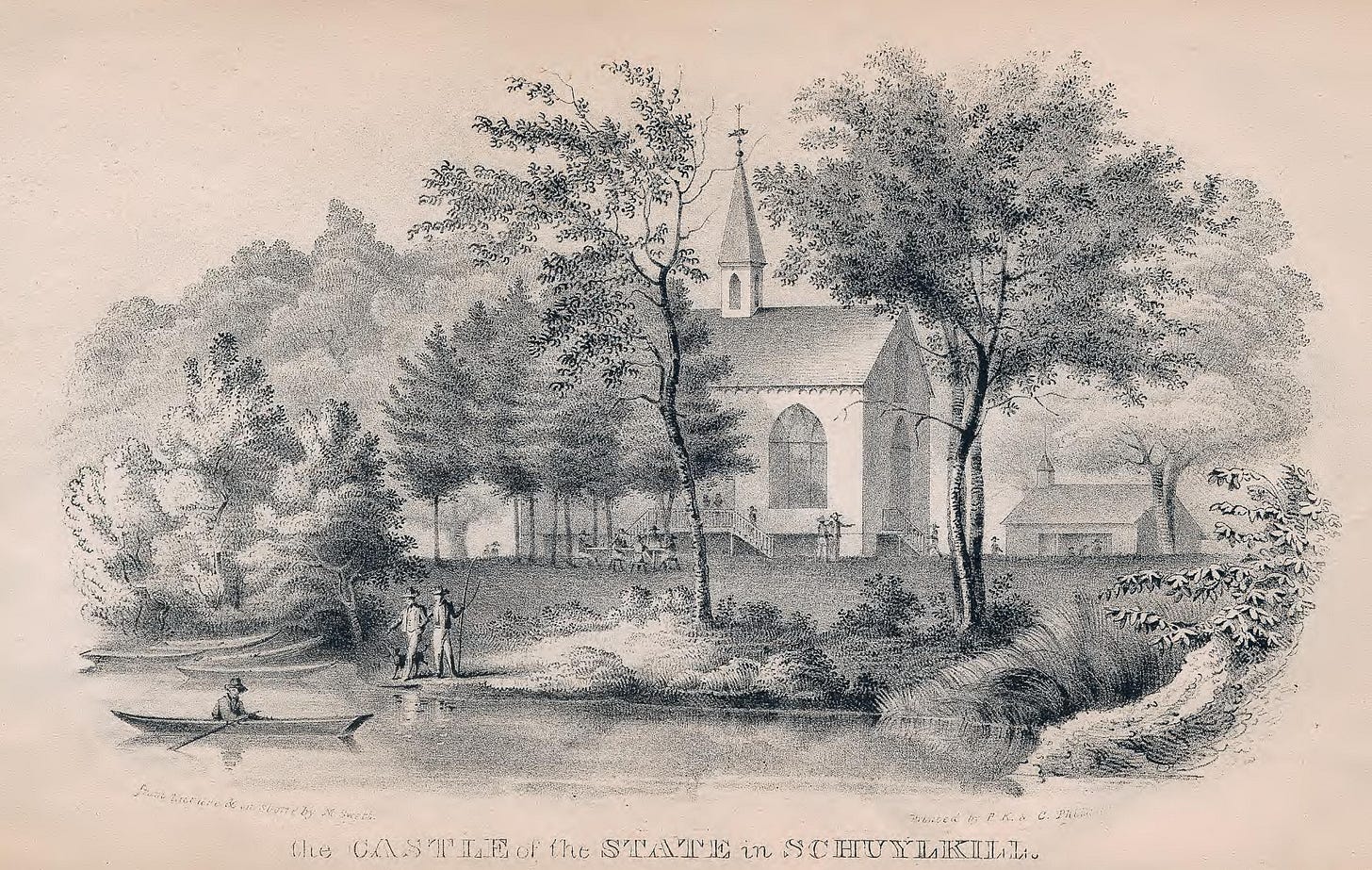
In July of 1824 the Maquis de Lafayette, the last surviving general of the Revolutionary War, was received by America’s oldest, and most exclusive, club, at their castle on the banks of the Schuylkill River. The Secretary of State of the sovereign State in Schuylkill addressed Lafayette:
The governor, council and citizens assembled, greet you and the gentlemen accompanying you, with a cordial welcome to the "State in Schuylkill."
Your visit here completes your tour to all the states in the union. We possess but a limited territory and population, but there are no limits to the joy we feel on this auspicious occasion … No event, save the war of the revolution, in which you, sir, bore so distinguished a part, ever interrupted the amusements of the Fishing Company of the Colony in Schuylkill. [W]hen its surviving citizen soldiers, exchanging the sword and the musket for the angling rod and the fowling piece, re-assembled as freemen, declared the independence of their state, and adopted that admirable recorded constitution of government1
Founded in 1732, the Colony in Schuylkill as it was known then, was founded as a club for hunting and fishing along the Schuylkill River. Its early members included many of Philadelphia’s first families. They built a castle wherein they would cook and eat the fish and game they caught. Many sportsmen clubs, social clubs, supper or “glutton clubs”2 as some were called, existed over the years, but the State in Schuylkill remains distinguished in its longevity and peculiarity.
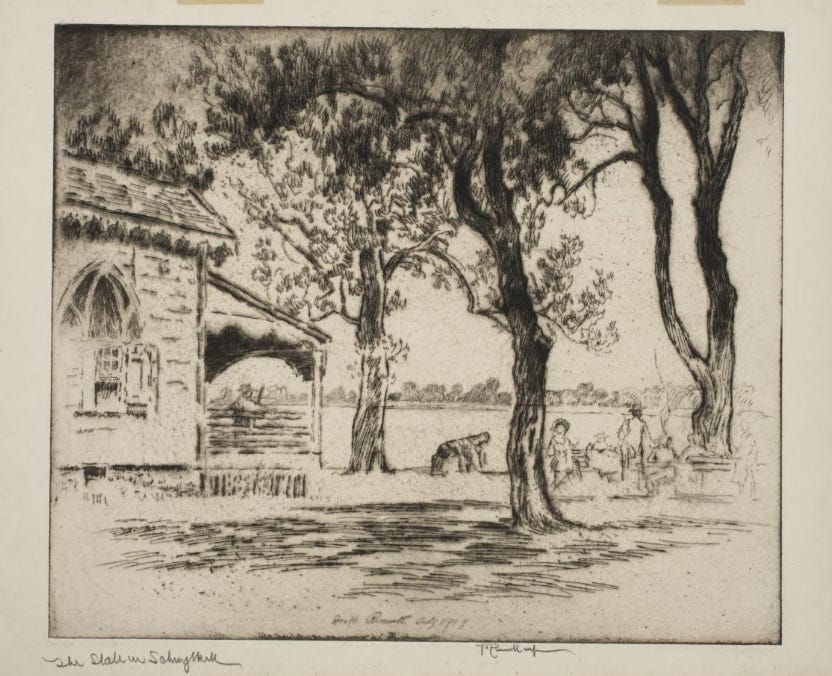
Limited to 32 members, or “citizens”, State in Schuylkill is modeled after a state3. It has a Governor, a Sherriff, a Coroner, a Secretary of State, a Navy, a constitution. The Sherrif issues “warrants” for game, and the Coroner reviews the catch after a successful hunt. As such a warrant dated 1744 stated:
To and all other Schuylkillians whom it may concern.
WHEREAS great quantities of rabbits, squirrels, pheasants, partridges, and others of the game kind, have presumed to infest the coasts and territories of Schuylkill, in a wild, bold and ungovernable manner; THESE are therefore to authorize and require you, or any of you to make diligent search for the said rabbits, squirrels, pheasants, partridges and others of the game kind, in all suspected places where they may be found, and bring the respective bodies of so many as you shall find, before the
Justices, at a general Court to be held on Thursday, the fourth day of October next, there to be proceeded against, as by the said court shall be adjudged; and for your or any of your so doing, this shall be your sufficient warrant. Witness, myself, the twenty-ninth day of September, in the twelfth year of my Government, and year of our Lord, one thousand seven hundred and forty-four.4
At this reception Lafayette was treated to an array of fish and game from the Schuylkill and surrounding area, prepared by the citizens of the State in Schuylkill. Before industrial era pollution made it impossible, the State would never serve food which was not caught by its citizens. Setting itself apart from other clubs of the time, all of the food and drink is prepared by the citizens. No servants, cooks, or hired help of any kind are permitted. The citizens, apprentices (citizens in waiting), and invited guests would don white aprons and straw fishermen’s hats to assist in the preparation and serving of dinner.
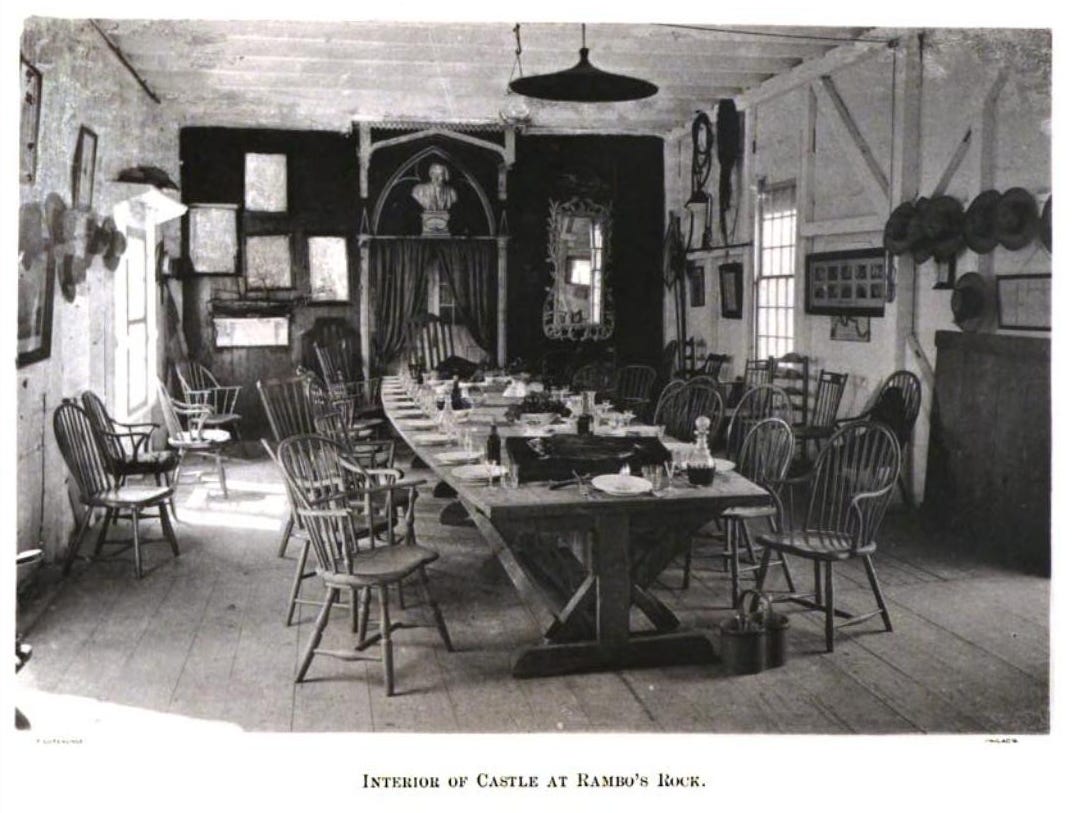
Lafayette would have been served Maderia wine, and a sweet citrus rum punch out of a china bowl of “mammoth size”, gifted to the State by Captain Charles Ross in 1822. Captain Ross5 had the bowl made in Canton (Guangzhou) China during one of his journeys for the East India Company. It was dubbed “the Ross Bowl” and it is said the citizens of the State in Schuylkill baptize their children in it6. The punch would become known as “Fish House Punch”.
Fish House Punch is a drink whose fame has exceeded its origins. It’s one of those cocktails, like an Old Fashioned or a Negroni, that has a mythology and air of mystery around it. You’ll hear that it’s a classic Philadelphia cocktail that dates back to colonial times. That it got George Washington so wasted he had a three-day hangover. That its recipe is a secret and has never been publicly available.
Fish House Punch is a drink “so innocent in tasted, but so quick and powerful in operation”7, it’ll “make you forget your mother-in-law”8. It’s a drink so deceptively mild you quaker aunt may mistake it for lemonade and have to be carried to bed9.
The punch was famous coast to coast by the 1880s, with mentions circulating in newspapers and periodicals from Boston to Fresno to Texas. In an article titled “IDENTIFIED BY HIS DRINKS: How Barkeeper's Detect The Nationality Of Their Customers” that was reprinted across the country for over a decade in the 1870s and 1880s10.
Philadelphians are noted as an unfussy bunch who when not taking “ale or beer, or whiskey straight”, opt for elevated drinks, “whiskey smashes, Roman punch, and Fish House punch”. Fish House Punch is honored by the author as “one of the nicest drinks know”, but notes that “the same drinks go by different names in different parts of the country”.
The recipe for Fish House Punch is still in debate today. The article notes Fish House Punch as a whisky and rum based drink, while more reliable recipes have it as rum and brandy based.
A Staunton Virginia establishment advertises itself in 1879 as the only place outside of “the Fish House Club” itself where one can enjoy an authentic Fish House Punch11
The spurious copies generally contain champagne and other liquids foreign to the primal compound, but the predominating trait of both original and counterfeit is that the mild taste of the punch is as "false as dicers' oaths" or woman's smiles. He who sips it for the first time imagines that he has been made immortal by the ambrosia of the gods, and only realizes, when he is under the table, that he still belongs to the earth earthy.12
The recipes available fall into two basic categories: a classical punch (rum, brandy, citrus, sugar) and a more modern midcentury punch (some combination of the first with the inclusion of champagne, soda water, or wine).
It is almost inconceivable that a colonial era punch would have included Champagne. And yet despite that, some of Philadelphia’s most prestigious clubs have served a Fish House Punch with a champagne base. The Union League’s recipe, published in 1981, is as follows13:
5 bottles of champagne
5 bottles of rye whiskey
one-half bottle of rum
1 bottle of apricot brandy
1 bottle of ginger ale
10 ounces of sugar water
5 bottles of club soda 1
2 ounces of lemon juice
Under a centuries long mystery, in 2018 it was discovered. Christian D'Andrea, entrepreneur and documentarian of The Weather Channel Fame, claims to have uncovered the real recipes in an unnamed archive.
In a website with some, interesting, photoshop and design choices, D’Andrea tells the story of Fish House Punch and the story of him finding the recipe. He now sells the concoction in flasks, and has done tastings and events at a number of prestigious clubs.
However, as the Philadelphia Inquirer revealed, there are several issues with D’Andrea’s claims. The first being, current citizens of State in Schuylkill say that the recipe is not a secret, that the real recipe was shared in with the Inquirer in 1992, and further the Governor at the time said:
We decided it wasn't worth it to sue the guy. We don't have a copyright or anything, I don't have any particular feelings about keeping the recipe a secret. I've shared it with friends. But that somebody would try to make money off of it is offensive to me … [s]ome of our members are down there to confront him and expose him for the fraud he is14
Now is my time to reveal: I too have a never before seen Fish House Punch recipe that I came across by chance in a dusty book. My recipe was from an undated memo from the Continental Distilling Corporation that I found folded inside of a copy of Philadelphia Scrapple that I purchased. Continental was post-prohibition distillery that offered a wide selection of spirits with delightfully midcentury & Philadelphia branding.
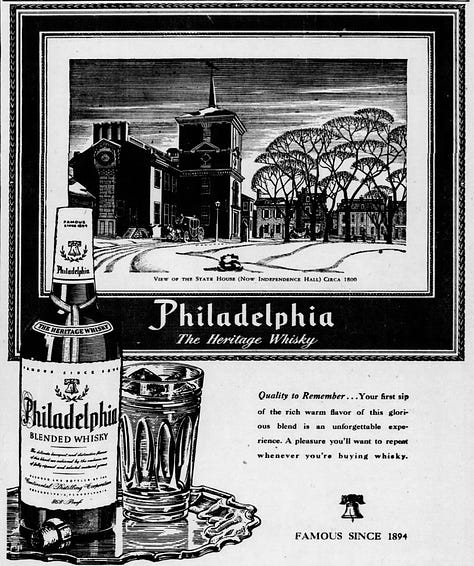

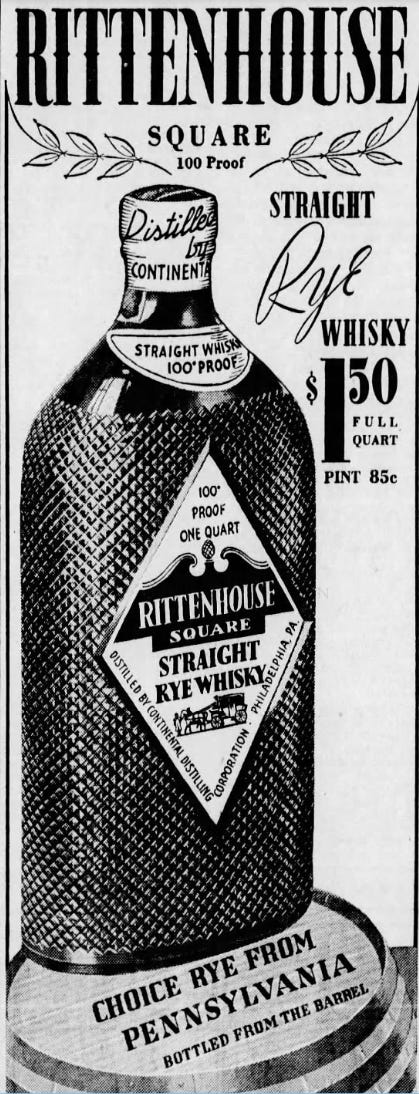
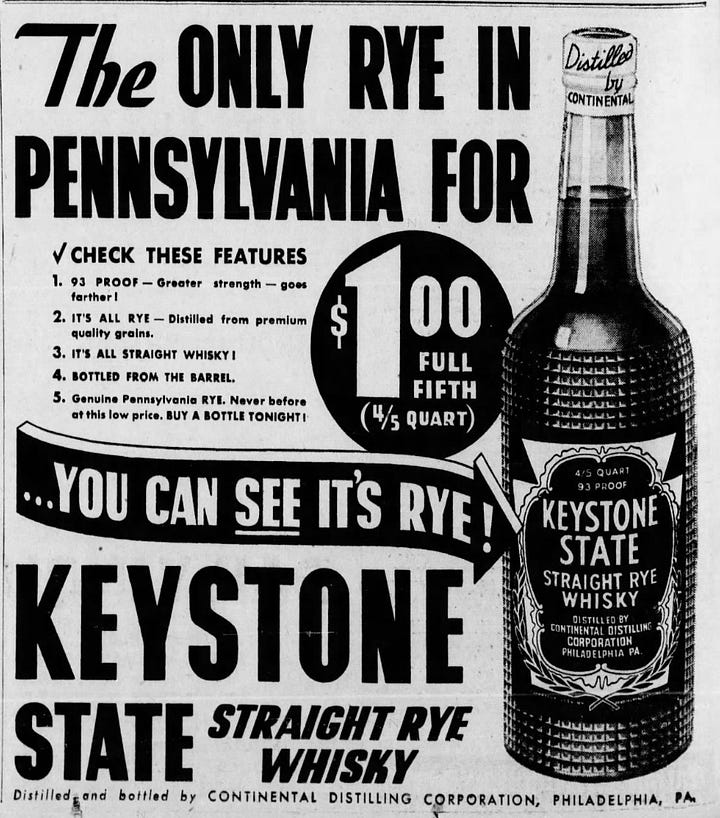
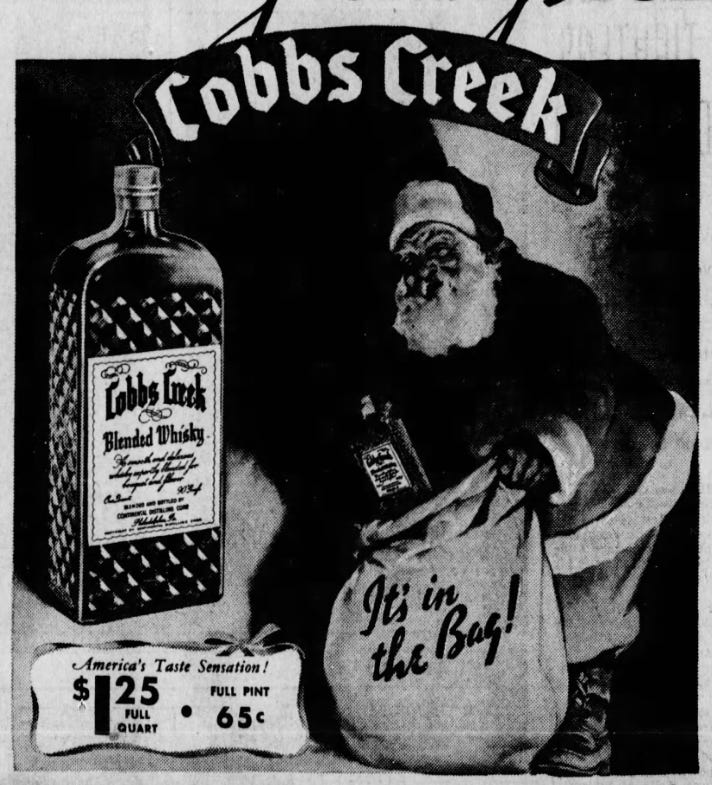
I am holding and exclusive tasting at my house tickets are on- no, of course I’ll share it with you. Part of my purpose behind writing here is increase access to inaccessible information. The recipe is fairly standard among the “traditional” recipes. Rum, Cognac, Brandy, Citrus, Sugar, Water. It’s one perhaps contribution to the corpus is the specification of “La Conga Rum”, a defunct 1950s brand of 125 proof rum. So, this recipe is calling for (in modern parlance) an over proof rum, which in an uncommon specified addition in recipes I reviewed.
I think, after going through all this research “the real Fish House Punch” was, so to say, the friends made along the way. This recipe has clearly varied over the years - and e even so, a natural drift in terminology and ingredient availability will change the product even if the recipe itself remains the same.
For instance, many recipes call for Peach Brandy. The Peach Brandy that you buy today in the liquor store (a cheap peach flavored brandy) is likely to be so different from the peach brandy of yesteryear (a brandy made from peaches) that it is basically a different product. Similarly with the overproof rum, our modern standards around proofing are, so to say, modern.
Even then, the nature of a punch is that it’s an “adjust to taste” type of recipe. Much like a stew or chili, you keep adding things until you’re happy with it. Punches don’t have a recipe so much as a guide.
This recipe has been adjusted and tinkered with over the years. It’s been adjusted to fit modern tastes. It’s been changed as certain products, spirits, and methods are more or less available. Theres an argument to be made that in a sense, there is no “real” Fish House Punch recipe. A Fish House Punch is a deceptively strong punch that you share with your friends and family, and maybe someone makes a fool of themselves. The legacy and meaning of Fish House Punch is more important than the technical construction.
Okay, but of course, I don’t actually believe that, and I’m not going to not provide you with what I think is the right recipe and construction of this drink.
In the process of writing this I reviewed, probably nearly 100 Fish House Punch recipes published in newspapers, books, and other places. I have also made this punch many times in my house.
In my opinion, the proper construction is:
Rum
Cognac
Peach Brandy
Sugar
Citrus
Water & Ice
I’m going to be honest, I don’t think the exact proportions matter that much. As I said earlier, punches are meant to be adjusted to taste - based on ingredients, based on local or temporal fashion, based on preference.
I am so sorry - so, so sorry - but if you are looking to make this drink, I suggest you start with the New York Times Cooking Recipe. I know that’s a bit of a letdown after thousands of words on newspaper archives and hidden recipes, but its (1) of a generally proper construction and (2) relatively approachable for a regular person. If you don’t want to have to convert to and from “drams”, “wine glasses”, “nips”, “loafs” as units of measurement, I’d recommend using the NYT or another modern recipe.
The critical — absolutely critical — thing in that recipe is the oleo-saccharum and letting the ultimate mixture sit for at least four hours (ideally twenty-four) before serving. Regardless of the exact recipe, recipes going back over 100 years speak to the need to take care in the construction of the punch and allowing the ingredients to sit for long enough.
Let no one imagine that Fish House Punch — or any punch, for that matter — can be hastily built on the spur of the moment. To build any punch properly takes time and care. The finest ingredients hastily thrown together and immediately served out will produce a rough and foul punch. A successful punch, besides painstaking care in the building, demands due time to mellow or season before it's fit to drink. This a good many people seem to forget.
In building Fish House Punch, slake the sugar in just enough water to dissolve it—it never dissolves properly in rum or spirits—and add it to the lemon juice, which should be strained through cheesecloth beforehand. Then pour the lemon juice over the ice; next, add the rum and spirits, and thus preserve the right sequence of ingredients in building a cold punch. Though it be not really necessary, if you add the spirits to the rum the night before you build the punch, cover the mixture tight, and then the next day pour it into the punch bowl where the lemon juice has already been poured over the lump of ice, you will have the comforting assurance that all the alcoholic elements have had ample time to amalgamate thoroughly.15
Another tip for serving is that dilution is important. The punch with be quite strong unless it’s diluted. When the punch is put out for serving, it should have a large block of ice in it to keep is cold and slowly melt over the course of the evening. I would suggest you also encourage your guests to drink it over ice to further dilute it. If you’re in a pinch (or don’t have ample ice) you can simply add water to taste.
Once you’ve made it off of the NYT Cooking recipe - I encourage experimentation! The history of this recipe is that people start with something they got from somewhere else and then make it their own. I in particular suggest trying different types / proofs of rum (I want to make one with Cachaça), as well as different brandies (the Mount Vernon Peach Brandy is my white whale - let me know if you’d like to organize a field trip).
Aug 02, 1825, page 2 - The Charleston Daily Courier at Newspapers.com
Full Text of the Address:
Dear General—The governor, council and citizens assembled, greet you and the gentlemen accompanying you, with a cordial welcome to the "State in Schuylkill."
Your visit here completes your tour to all the states in the union. We possess but a limited territory and population, but there are no limits to the joy we feel on this auspicious occasion.—It is now nearly a century since some of the worthiest and most eminent men of our parent colony of Pennsylvania associated on the banks of our beautiful river, and founded this institution, with a view to occasional relaxation from the cares and fatigues of business. The waters and woods furnished abundance of game, and the pursuit of it, and its preparation for the festive board, at once contributed to the delight and the health of the sportsmen.
No event, save the war of the revolution, in which you, sir, bore so distinguished a part, ever interrupted the amusements of the Fishing Company of the Colony in Schuylkill. Its independence is coeval with the close of that contest, when its surviving citizen soldiers, exchanging the sword and the musket for the angling rod and the fowling piece, re-assembled as freemen, declared the independence of their state, and adopted that admirable recorded constitution of government, under which, like her associated sisters of the union, she has continued to prosper, and her citizens to enjoy those sporting privileges and frugal festivities you will witness and partake of this day.
Lafayette’s Reply:
My Dear Sir—I feel sincere pleasure in visiting your ancient institution, so pleasantly situated on the banks of your beautiful river. It is the more grateful to me, as it completes my tour to all the states in the union. About half a century ago I first crossed this stream in times of war. Far different now are the sensations I realize, in meeting my friends on so pleasant an occasion. I feel honored by your polite invitation to your ancient and agreeable State in Schuylkill: May you long continue happy and prosperous.
Annals of Philadelphia - Google Books - Page 166
Outing and the Wheelman - Google Books - Page 535
The Larder Invaded - Google Books - Page 54
Philadelphia Scapple - Page 108
https://www.inquirer.com/philly/news/the-perfect-scam-prove-this-isnt-a-286-year-old-cocktail-recipe-from-phillys-oldest-secret-club-20180822.html
Philadelphia Scrapple - Page 109








